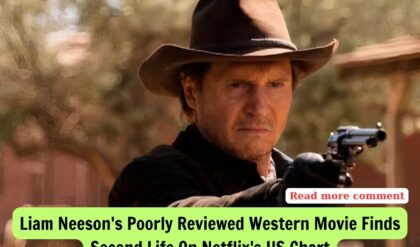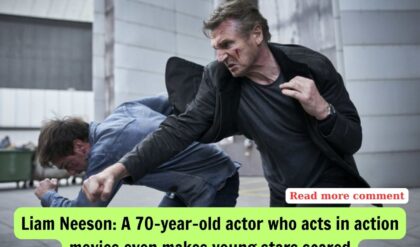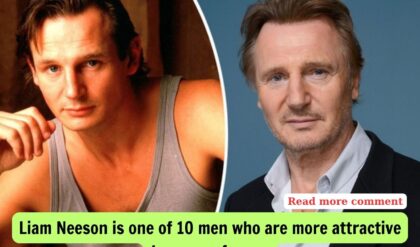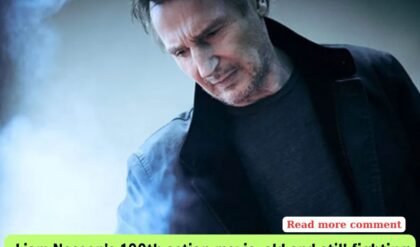The Irish actor stars in “Marlowe”, alongside Diane Kruger and marking the return to film noir of Neil Jordan, who adapts the mythical character created by Raymond Chandler in the film

The scene could perfectly be a kind of post-credits sequence for the film . Behind the door of a luxurious hotel, a snowy, round table awaits. And wait. A good time. From the doorway, a guy finally appears who is about to reach two meters , long but almost also wide, defiant, with a toothpick in his mouth . He only interrupts his whistle to pour himself a sparkling water and, now acclimatized, asks: ” Gentlemen, did you like the movie?” Because if not, we can fix it in an instant,” he jokes with a subtle laugh, rolling up his shirt sleeves as if he were going to fight .
It seems incredible that we are sitting in front of Qui-Gon Jinn or Oskar Schindler , but, in reality, we are in front of detective Philip Marlowe . Or, at least, in front of the most vivid image that director Neil Jordan has been able to create through Liam Neeson (Ireland, 1952). The renowned actor visited the last San Sebastian Festival to present “Marlowe” , a film adaptation of the mythical character born in the novels of Raymond Chandler and who here comes to life following the canonical codes of film noir .

A classic legacy
Thus, with the gun (the excuse for the interview) and the cigarette (the toothpick) present in the room , only the girl is missing . And that’s right when Nesson’s co-star, Diane Kruger , here enters, without a single hair out of place, here the daughter of a famous actress of golden Hollywood (in the film, Jessica Lange ) who disappears, starting a convoluted investigation that the director of “Interview with the Vampire” or “The Crying Game” knows how to hold, knows how to separate it from the novel and, above all, knows how to complicate it just enough to be able to look at the melodrama from afar.
“Yes, as soon as I knew I was going to make the film I wanted to see the adaptations that had been made before,” explains Neeson about an love affair, Marlowe’s with cinema , which began with the end of World War II . Of the dozen films in which the troubled detective has starred, perhaps the best, or at least the most faithful, is “A Long Goodbye” (1973), directed by Robert Altman and with Elliot Gould in the lead role. But if we are referring to mysticism, the ability to enclose the character in celluloid and make it iconic, the most mythical adaptation was the 1949 adaptation, “The Big Sleep” , starring Humphrey Bogart and Lauren Bacall . Who does Neeson consider himself the successor to? «Well, neither of the two most mythical. My favorite performance is Robert Mitchum’s in ”Goodbye, Doll” . I saw that movie when I was a teenager and it marked me, I would almost say it made me want to be an actor. He was a guy who managed to make the job attractive. But I also really like Gould’s, largely because there is not a single sequence in the entire film in which he does not have a cigarette in his hand or in his mouth,” explains the actor.
At his side, undaunted, Kruger nods and prepares to reveal her character, an archetypal “femme-fatale” , yes, but revised in an elegant way, as an heir to those who have given their name to the cinephile vice, but aware of its contextuality. : «I thought the script was wonderful, it hooked me from the first page.
Also because my character plays in a different division . She is her daughter, yes, but she is a director of a film studio, she is not a lady in distress. And the entire mystery of the movie doesn’t revolve around who she loved , for example.
But it has also been a very fun film, entertaining to shoot, thanks to the setting and the sets, it was an immersive experience,” the actress specifies before Neeson clarifies: “It is extraordinary how Neil (Jordan) works the mystery. And how did Diane understand it, since she never reveals to us who her character really is. That is incredibly attractive as an actor .
Regarding the rereading of clichés, and about not making a “noir” film in the style of those of the post-war period in our era , Neeson surprises with his response: “It’s very curious, because much of this updating work happens for something, priori, not as important in that work as the soundtrack.
I was able to see a rough cut of the film without David Holmes’ music, but once its soundtrack is included, the film improves in its entirety and, above all, it seems contemporary despite what you are seeing and the era to which it is taking you.
And for the record, I’m not saying this because he’s Irish,” explains the new Marlowe, before Kruger takes him to the situation, revising gender roles through : “I don’t think it has so much to do with the more drastic episodes, like the #MeToo, as if with the mere adaptation to the times.
The film is not a political statement, but it is normal that screenwriters of our time do not write female roles like those of the 1940s. It is a simple adaptation, it is not written with fear , because that would be terrible,” he adds.
And the new “Marlowe” , even contained in a 110-minute film, is felt on the big screen like a film from another time, like a neoclassical exercise in which Jordan pours, more than a specific drive, all his behind-the-scenes experience.
Much of this lies, of course, in a period piece, in the production design (the work of John Beard , art director of Terry Gilliam ‘s “Brazil” ), but also in the truly effortful performances of Neeson, Kruger and Lange, finally recovered for the cinema of great scripts after her time in the series.
Hero of the mamporro
«It was not a conscious choice. It was something that I really owe to my agent and my wife . I had made a lot of violent movies, yes, and I was a boxer in my adolescence, so I guess it was something that had to end up happening, but they never offered me action protagonists,” explains Neeson, sincere about his reconversion to a swordsman hero in films such as “Revenge” , “Without Identity” or “The Passenger” , before turning it into an anecdote to honor Natasha Richardson , with whom he was married for thirteen years until her sudden death in 2009: “I accompanied my wife to a festival in Shanghai, and Luc Besson was there . There he told me the idea he had for “Revenge”, in case someone occurred to me, and I told him to put me on his list. He was surprised, because he didn’t expect me to want to participate .
And I actually gave it a second thought, because we really believed it was going to be a straight-to-DVD movie . But that was, actually, what convinced me. Natasha told me to take a chance, because if it didn’t end up in theaters, it would become a minor failure. And here we are, twenty-seven movies later and with an action scene coordinator and stuntman as a best friend,” Neeson concludes.
With considerably fewer punches per minute, but already with that angry pose even embraced by the person beyond the character, Neeson’s Marlowe is certainly more silent, more intellectual, definitely more cerebral than his predecessors in the mythical role, here reviewed under the eyes of a John Banville who borrows from Chandler’s character: «I wanted to do something different, so I looked directly at the books. I read everything I could to find my own Marlowe.
What was that guy like? That whole process was completed as soon as I put on the hat . “He just felt good, I felt good being that guy,” completes the Irish actor, an incombustible and converted star, a strict paradigm, perhaps, of that modern Hollywood in which the most important thing is to know how to renew oneself to avoid dying.





